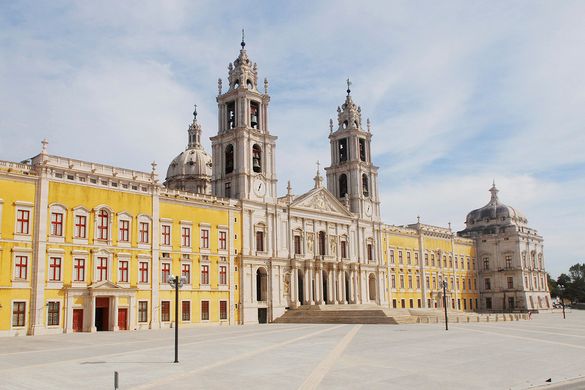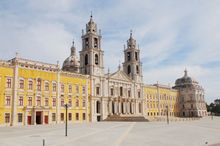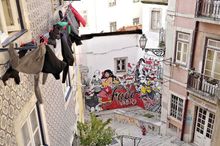 16 Aug 2024
16 Aug 2024
Famous for its historical charm, year-round sunshine, canary-yellow trams and nearby beaches, Lisbon is also home to an array of cultural attractions that are unique to the region. From music to design to delicious foods, the team at Visit Lisboa (visitlisboa.com/en) has picked out several that showcase Lisbon's distinctive charm.
Mafra carillons
The National Palace of Mafra is home to one of the world's largest sets of carillons, a musical instrument that looks like a piano, with keys of wooden batons that are linked to more than 100 bells in two 50-metre-tall towers. Each bell produces a different note, creating a rich sound that can be heard for miles. Installed in the 18th century, the bells were silenced for 20 years in the early 2000s, before being refurbished and played again in 2020. Visitors can enjoy scheduled performances that highlight the intricate craftsmanship and historical significance of these grand instruments for an auditory experience that reflects the grandeur of the palace itself.
Lisbon's Azulejos Tiles
Look up to spot Lisbon's iconic azulejos. These ceramic tiles are often painted in blue and white with scenes from Portuguese history, mythology and everyday life, and they decorate buildings, churches and public spaces. The National Azulejo Museum is dedicated to preserving this art form and has an extensive collection that traces the evolution of azulejos from the 15th century to the present.
Calçada Portuguesa (Portuguese Pavement)
Look down to discover Lisbon's Calçada Portuguesa, intricate black-and-white mosaic patterned pavements. Made from hand-cut limestone and basalt, these traditional pavements often depict geometric designs, historical scenes and nautical motifs celebrating Portugal's Age of Discoveries, with some of the best examples found in Rossio Square, Avenida da Liberdade, and Praça do Comércio.
Fado Music
The sound of Fado is part of Lisbon's DNA, so embedded the society that it is included on UNESCO's list of intangible cultural heritage. Born in the streets, houses and on the riverside of Lisbon, these poetic stories of love and fate are brought to life by the combination of guitar and emotional vocals and can be heard in traditional Fado houses in the historic neighbourhoods of Alfama, Bairro Alto and Mouraria.
Pasteis de Belem
Pasteis de Nata are the famous flaky custard tarts that can be found all over Portugal, but the original tarts were developed in Belem and have a secret recipe. First made by monks at the Jerónimos Monastery, the recipe was sold in the 1830s to the nearby Fábrica de Pastéis de Belém, which has been producing the tarts ever since and is the only place in the world where the original recipe is known.
Cunhal das Bolas Palace in Bairro Alto
Lisbon is full of eye-catching architecture, but one of the city's lesser-known surprises is the 17th-century Cunhal das Bolas Palace, located in the vibrant Bairro Alto district. This palace stands out with its distinctive corner adorned with stone spheres, hence the name "Cunhal das Bolas" (Corner of Balls), which are thought to have once been covered in gold.
Windows to the past
One of Europe's oldest cities, Lisbon has several UNESCO World Heritage listed sites, historical attractions and museums to see. Top attractions include the Belém Tower, a symbol of Portuguese maritime power during the Age of Discoveries, the Jerónimos Monastery, a lavish masterpiece of Manueline architecture and the towering São Jorge Castle which looks down on the narrow streets and colourful houses decorated with Azulejos tiles within the historic Alfama district. For museums and art, must-visits include the Calouste Gulbenkian Museum, which hosts one of Europe's best private art collections, the majestic Museum of Art, Architecture and Technology (MAAT) and the Royal Treasury Museum displaying former possessions of the Portuguese Royal Family.
For more information, ideas, and inspiration on visiting Lisbon and the Tagus River, go to www.visitlisboa.com.
-Ends-
Notes to editors
About Turismo de Lisboa
Turismo de Lisboa is a non-profit organisation established through an alliance of public and private bodies operating in the tourist sector. It has around 900 associated members. Since its inception in 1998, the main objective of this association is to improve and increase the promotion of Lisboa as a tourist destination and therefore enhance the quality and competitiveness of the city.
For media information and images, please contact Hume Whitehead Ltd:
Richard Hume (richard@humewhitehead.co.uk / 020 3375 4050)
Daniel Johnson (dan@humewhitehead.co.uk / 07429 256 670)
Rebecca Pasha (rebecca@humewhitehead.co.uk / 020 3375 4054 or 020 3375 4050)





